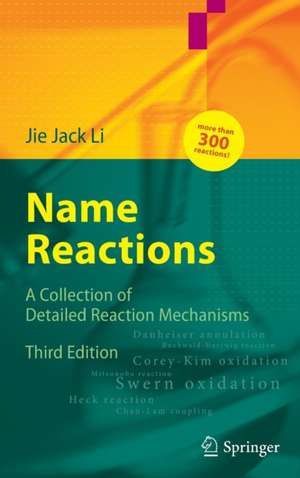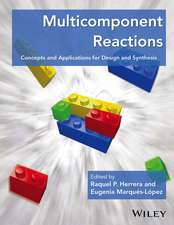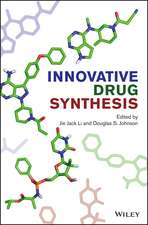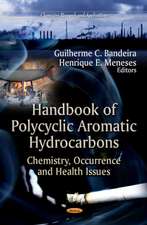Name Reactions: A Collection of Detailed Mechanisms and Synthetic Applications
Autor Jie Jack Lien Limba Engleză Hardback – 19 iul 2006
| Toate formatele și edițiile | Preț | Express |
|---|---|---|
| Paperback (2) | 483.50 lei 6-8 săpt. | |
| Springer International Publishing – 29 ian 2022 | 483.50 lei 6-8 săpt. | |
| Springer International Publishing – 23 aug 2016 | 599.47 lei 6-8 săpt. | |
| Hardback (3) | 413.75 lei 6-8 săpt. | |
| Springer Berlin, Heidelberg – 19 iul 2006 | 413.75 lei 6-8 săpt. | |
| Springer – 12 feb 2014 | 571.43 lei 38-44 zile | |
| Springer International Publishing – 29 ian 2021 | 590.09 lei 38-44 zile |
Preț: 413.75 lei
Nou
Puncte Express: 621
Preț estimativ în valută:
79.22€ • 81.26$ • 66.70£
79.22€ • 81.26$ • 66.70£
Carte tipărită la comandă
Livrare economică 26 februarie-12 martie
Preluare comenzi: 021 569.72.76
Specificații
ISBN-13: 9783540300304
ISBN-10: 3540300309
Pagini: 672
Ilustrații: XX, 653 p.
Dimensiuni: 155 x 235 x 42 mm
Greutate: 1.09 kg
Ediția:3rd. expanded ed.
Editura: Springer Berlin, Heidelberg
Colecția Springer
Locul publicării:Berlin, Heidelberg, Germany
ISBN-10: 3540300309
Pagini: 672
Ilustrații: XX, 653 p.
Dimensiuni: 155 x 235 x 42 mm
Greutate: 1.09 kg
Ediția:3rd. expanded ed.
Editura: Springer Berlin, Heidelberg
Colecția Springer
Locul publicării:Berlin, Heidelberg, Germany
Public țintă
GraduateCuprins
Alder ene reaction.- Aldol condensation.- Algar-Flynn-Oyamada Reaction.- Allan-Robinson reaction.- Appel reaction.- Arndt-Eistert homologation.- Baeyer-Villiger oxidation.- Baker-Venkataraman rearrangement.- Bamberger rearrangement.- Bamford-Stevens reaction.- Barbier coupling reaction.- Bargellini reaction.- Bartoli indole synthesis.- Barton radical decarboxylation.- Barton-McCombie deoxygenation.- Barton nitrite photolysis.- Barton-Zard reaction.- Batcho-Leimgruber indole synthesis.- Baylis-Hillman reaction.- Beckmann rearrangement.- Beirut reaction.- Benzilic acid rearrangement.- Benzoin condensation.- Bergman cyclization.- Biginelli pyrimidone synthesis.- Birch reduction.- Bischler-Möhlau indole synthesis.- Bischler-Napieralski reaction.- Blaise reaction.- Blanc chloromethylation.- Blum aziridine synthesis.- Boekelheide reaction.- Boger pyridine synthesis.- Borch reductive amination.- Borsche-Drechsel cyclization.- Boulton-Katritzky rearrangement.- Bouveault aldehyde synthesis.- Bouveault-Blanc reduction.- Boyland-Sims oxidation.- Bradsher reaction.- Brook rearrangement.- Brown hydroboration.- Bucherer carbazole synthesis.- Bucherer reaction.- Bucherer-Bergs reaction.- Büchner-Curtius-Schlotterbeck reaction.- Büchner method of ring expansion.- Buchwald-Hartwig C-N and C-O bond formation reactions.- Burgess dehydrating reagent.- Cadiot-Chodkiewicz coupling.- Camps quinolinol synthesis.- Cannizzaro disproportionation.- Carroll rearrangement.- Castro-Stephens coupling.- Chan alkyne reduction.- Chan-Lam coupling reaction.- Chapman rearrangement.- Chichibabin pyridine synthesis.- Chugaev elimination.- Ciamician-Dennsted rearrangement.- Claisen condensation.- Claisen isoxazole synthesis.- Claisen rearrangements.- Clemmensen reduction.- Combes quinoline synthesis.-Conrad-Limpach reaction.- Cope elimination reaction.- Cope rearrangement.- Corey-Bakshi-Shibata (CBS) reduction.- Corey-Chaykovsky reaction.- Corey-Fuchs reaction.- Corey-Kim oxidation.- Corey-Nicolaou macrolactonization.- Corey-Seebach reaction.- Corey-Winter olefin synthesis.- Criegee glycol cleavage.- Criegee mechanism of ozonolysis.- Curtius rearrangement.- Dakin oxidation.- Dakin-West reaction.- Danheiser annulation.- Darzens glycidic ester condensation.- Davis chiral oxaziridine reagents.- Delépine amine synthesis.- de Mayo reaction.- Demjanov rearrangement.- Dess-Martin periodinane oxidation.- Dieckmann condensation.- Diels-Alder reaction.- Dienone-phenol rearrangement.- Di-?-methane rearrangement.- Doebner quinoline synthesis.- Dötz reaction.- Dowd-Beckwith ring expansion.- Erlenmeyer-Plöchl azlactone synthesis.- Eschenmoser-Tanabe fragmentation.- Eschweiler-Clarke reductive alkylation of amines.- Evans aldol reaction.- Favorskii rearrangement and quasi-Favorskii rearrangement.- Feist-Bénary furan synthesis.- Ferrier carbocyclization.- Ferrier glycal allylic rearrangement.- Fiesselmann thiophene synthesis.- Fischer indole synthesis.- Fischer oxazole synthesis.- Fleming-Kumada oxidation.- Friedel-Crafts reaction.- Friedländer quinoline synthesis.- Fries rearrangement.- Fukuyama amine synthesis.- Fukuyama reduction.- Gabriel synthesis.- Gabriel-Colman rearrangement.- Gassman indole synthesis.- Gattermann-Koch reaction.- Gewald aminothiophene synthesis.- Glaser coupling.- Gomberg-Bachmann reaction.- Gould-Jacobs reaction.- Grignard reaction.- Grob fragmentation.- Guareschi-Thorpe condensation.- Hajos-Wiechert reaction.- Haller-Bauer reaction.- Hantzsch dihydropyridine synthesis.- Hantzsch pyrrole synthesis.- Heck reaction.- Hegedus indole synthesis.-Hell-Volhard-Zelinsky reaction.- Henry nitroaldol reaction.- Hinsberg synthesis of thiophene derivatives.- Hiyama cross-coupling reaction.- Hofmann rearrangement.- Hofmann-Löffler-Freytag reaction.- Horner-Wadsworth-Emmons reaction.- Houben-Hoesch reaction.- Hunsdiecker-Borodin reaction.- Hurd-Mori 1,2,3-thiadiazole synthesis.- Jacobsen-Katsuki epoxidation.- Japp-Klingemann hydrazone synthesis.- Jones oxidation.- Julia-Kocienski olefination.- Julia-Lythgoe olefination.- Kahne-Crich glycosidation.- Keck macrolactonization.- Knoevenagel condensation.- Knorr pyrazole synthesis.- Koch-Haaf carbonylation.- Koenig-Knorr glycosidation.- Kolbe-Schmitt reaction.- Kostanecki reaction.- Kröhnke pyridine synthesis.- Kumada cross-coupling reaction.- Lawesson’s reagent.- Leuckart-Wallach reaction.- Lossen rearrangement.- McFadyen-Stevens reduction.- McMurry coupling.- MacMillan catalyst.- Mannich reaction.- Marshall boronate fragmentation.- Martin’s sulfurane dehydrating reagent.- Masamune-Roush conditions.- Meerwein-Ponndorf-Verley reduction.- Meisenheimer complex.- [1,2]-Meisenheimer rearrangement.- [2,3]-Meisenheimer rearrangement.- Meth-Cohn quinoline synthesis.- Meyers oxazoline method.- Meyer-Schuster rearrangement.- Michael addition.- Michaelis-Arbuzov phosphonate synthesis.- Midland reduction.- Mislow-Evans rearrangement.- Mitsunobu reaction.- Miyaura borylation.- Moffatt oxidation.- Montgomery coupling.- Morgan-Walls reaction.- Mori-Ban indole synthesis.- Mukaiyama aldol reaction.- Mukaiyama Michael addition.- Mukaiyama reagent.- Myers-Saito cyclization.- Nazarov cyclization.- Neber rearrangement.- Nef reaction.- Negishi cross-coupling reaction.- Nenitzescu indole synthesis.- Nicholas reaction.- Nicolaou dehydrogenation.- Nicolaou hydroxy-dithioketal cyclization.-Nicolaou hydroxy-ketone reductive cyclic ether formation.- Nicolaou oxyselenation.- Noyori asymmetric hydrogenation.- Nozaki-Hiyama-Kishi reaction.- Oppenauer oxidation.- Overman rearrangement.- Paal thiophene synthesis.- Paal-Knorr furan synthesis.- Parham cyclization.- Passerini reaction.- Paternó-Büchi reaction.- Pauson-Khand cyclopentenone synthesis.- Payne rearrangement.- Pechmann coumarin synthesis.- Perkin reaction.- Petasis reaction.- Peterson olefination.- Pictet-Gams isoquinoline synthesis.- Pictet-Spengler tetrahydroisoquinoline synthesis.- Pinacol rearrangement.- Pinner reaction.- Polonovski reaction.- Polonovski-Potier reaction.- Pomeranz-Fritsch reaction.- Prévost trans-dihydroxylation.- Prins reaction.- Pschorr cyclization.- Pummerer rearrangement.- Ramberg-Bäcklund reaction.- Reformatsky reaction.- Regitz diazo synthesis.- Reimer-Tiemann reaction.- Reissert aldehyde synthesis.- Reissert indole synthesis.- Ring-closing metathesis (RCM).- Ritter reaction.- Robinson annulation.- Robinson-Gabriel synthesis.- Robinson-Schöpf reaction.- Rosenmund reduction.- Rubottom oxidation.- Rupe rearrangement.- Saegusa oxidation.- Sakurai allylation reaction.- Sandmeyer reaction.- Schiemann reaction.- Schmidt reaction.- Schmidt’s trichloroacetimidate glycosidation reaction.- Shapiro reaction.- Sharpless asymmetric amino hydroxylation.- Sharpless asymmetric epoxidation.- Sharpless asymmetric dihydroxylation.- Sharpless olefin synthesis.- Simmons-Smith reaction.- Skraup quinoline synthesis.- Smiles rearrangement.- Sommelet reaction.- Sommelet-Hauser rearrangement.- Sonogashira reaction.- Staudinger ketene cycloaddition.- Staudinger reduction.- Sternbach benzodiazepine synthesis.- Stetter reaction.- Still-Gennari phosphonate reaction.- Stille coupling.- Stille-Kellyreaction.- Stobbe condensation.- Stork enamine reaction.- Strecker amino acid synthesis.- Suzuki coupling.- Swern oxidation.- Takai iodoalkene synthesis.- Tebbe olefination.- TEMPO-mediated oxidation.- Thorpe-Ziegler reaction.- Tsuji-Trost reaction.- Ugi reaction.- Ullmann reaction.- van Leusen oxazole synthesis.- Vilsmeier-Haack reaction.- Vilsmeier mechanism for acid chloride formation.- Vinylcyclopropane-cyclopentene rearrangement.- von Braun reaction.- Wacker oxidation.- Wagner-Meerwein rearrangement.- Weiss-Cook reaction.- Wharton oxygen transposition reaction.- Willgerodt-Kindler reaction.- Wittig reaction.- [1,2]-Wittig rearrangement.- [2,3]-Wittig rearrangement.- Wohl-Ziegler reaction.- Wolff rearrangement.- Wolff-Kishner reduction.- Yamaguchi esterification.- Zincke reaction.
Textul de pe ultima copertă
The third edition contains major improvements over the previous edition. In addition to updated references, each reaction is now supplemented with two to three representative examples in synthesis to showcase its synthetic utility. Biographical sketches for the chemists who discovered or developed those name reactions have been included. Furthemore, the subject index is significantly expanded.
Different from other books on name reactions in organic chemistry, Name Reactions, A Collection of Detailed Reaction Mechanisms focuses on their mechanisms. It covers over 300 classical as well as contemporary name reactions. Each reaction is delineated by its detailed step-by-step, electron-pushing mechanism, supplemented with the original and the latest references, especially review articles. Thus, it is not only an indispensable resource for senior undergraduate and graduate students for learning and exams, but also a good reference book for all chemists interested in name reactions.
Some praise for the previous edition:
"This is an excellent book for arrow pushing and learning organic name reactions as encountered in graduate school . . . Li’s book contains reactions of all mechanistic classes . . . The book is nicely balanced, containing modern-day reactions for assembly of stereocomplex molecules. Reactions such as the Corey-Bakshi-Shibata reduction are analyzed. This book is a good reference text that fills a void that has existed for some time. It is both an excellent tool for learning and a good reference source."
JOURNAL OF CHEMICAL EDUCATION
Different from other books on name reactions in organic chemistry, Name Reactions, A Collection of Detailed Reaction Mechanisms focuses on their mechanisms. It covers over 300 classical as well as contemporary name reactions. Each reaction is delineated by its detailed step-by-step, electron-pushing mechanism, supplemented with the original and the latest references, especially review articles. Thus, it is not only an indispensable resource for senior undergraduate and graduate students for learning and exams, but also a good reference book for all chemists interested in name reactions.
Some praise for the previous edition:
"This is an excellent book for arrow pushing and learning organic name reactions as encountered in graduate school . . . Li’s book contains reactions of all mechanistic classes . . . The book is nicely balanced, containing modern-day reactions for assembly of stereocomplex molecules. Reactions such as the Corey-Bakshi-Shibata reduction are analyzed. This book is a good reference text that fills a void that has existed for some time. It is both an excellent tool for learning and a good reference source."
JOURNAL OF CHEMICAL EDUCATION
Caracteristici
Many chemists collect named and unnamed reactions and their mechanisms Will make this time-consuming effort redundant Gives the earliest and latest references to these name reactions Gives representative examples in synthesis
Notă biografică
Jie Jack Li earned his Ph.D. in organic chemistry in 1995 at Indiana University. After a stint as a postdoctoral fellow MIT, he worked as a medicinal chemist at Pfizer and Bristol-Myers Squibb from 1997 to 2012. He is now an Associate Professor of Chemistry at the University of San Francisco teaching organic and medicinal chemistry. He has published 17 books ranging from organic chemistry, medicinal chemistry to the history of drug discovery. Most recent books include: Total Synthesis of Natural Products: At the Frontiers of Organic Chemistry (2013, Springer) with E.J. Corey; Drug Discovery: Practices, Processes, and Perspectives, (2013, Wiley) with E.J. Corey; Modern Drug Synthesis (2010, Wiley), with Doug Johnson; and Triumph of the Heart-the Story of Statins (2009, Oxford University Press).
Recenzii
From
the
book
reviews:
“Li (Univ. of San Francisco; formerly, Pfizer and Bristol-Myers Squibb) continues to update and improve his series on named organic chemical reactions with this fifth edition … . The book illustrates the stepwise mechanisms of each reaction, making it an excellent teaching tool for undergraduates. Academic libraries supporting organic chemistry programs as well as professional organic chemists will want to own this book. … Summing Up: Recommended. Lower-division undergraduates through professionals/practitioners.” (R. E. Buntrock, Choice, Vol. 52 (3), November, 2014)
“Li (Univ. of San Francisco; formerly, Pfizer and Bristol-Myers Squibb) continues to update and improve his series on named organic chemical reactions with this fifth edition … . The book illustrates the stepwise mechanisms of each reaction, making it an excellent teaching tool for undergraduates. Academic libraries supporting organic chemistry programs as well as professional organic chemists will want to own this book. … Summing Up: Recommended. Lower-division undergraduates through professionals/practitioners.” (R. E. Buntrock, Choice, Vol. 52 (3), November, 2014)











